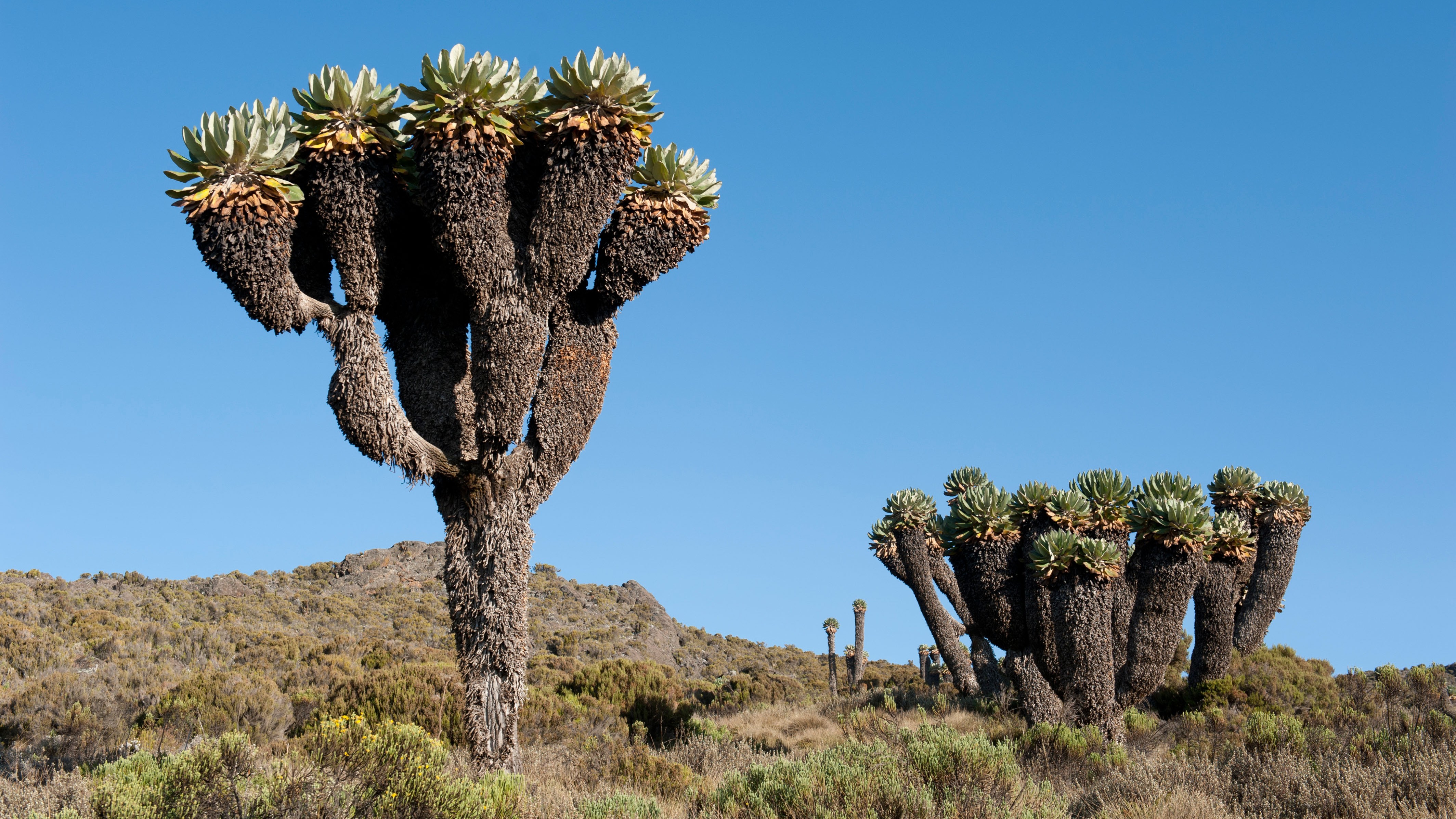QUICK FACTS
Name: Mount Kilimanjaro
Location: Kilimanjaro National Park, northeast Tanzania
Coordinates: -3.067192481296387, 37.355526051878165
Why it’s incredible: Kilimanjaro hosts huge, endemic plants called giant groundsels.
On the middle-altitude slopes of Mount Kilimanjaro grows a strange plant not found anywhere else on Earth. The giant groundsel, a plant that looks like a pineapple crossed with a saguaro cactus, colonized the flanks of Africa’s tallest mountain up to 1 million years ago and has not budged since.
Kilimanjaro’s giant groundsels (Dendrosenecio kilimanjari) grow at altitudes of between 9,200 and 13,100 feet (2,800 to 4,000 meters), where they get just enough rainfall to survive, according to the tour operator Tranquil Kilimanjaro. The plants have evolved adaptations to the harsh conditions on the mountain, including water storage systems and a protective jacket of dead leaves.
Located in northeast Tanzania, the base of Mount Kilimanjaro is hot and humid, but temperatures at the summit, which is 19,340 feet (5,895 m) above sea level, can drop to minus 20 degrees Fahrenheit (minus 29 degrees Celsius). The mountain “creates its own weather,” according to the tour operator Climbing Kilimanjaro, with baking sunshine, snow, rain and bitter winds all possible at different altitudes at any time of the year.
Giant groundsels have evolved to cope with this variable climate. Their thick stems are topped with a crown of sturdy leaves covered in hairs that limit how much water escapes the plant by evaporation. Both the stem and the leaves store water for when the climate is dry, usually from December to March and June to October.
The plants are also well equipped to survive a wide range of temperatures. When their leaves die, they fold over the stem and create a thick layer of insulation against the cold. Additionally, giant groundsels ooze “antifreeze” substances that enable the plants to grow above the tree line.
Related: Romania’s trovants: The bulbous ‘living’ rocks that inspired folkloric tales of dinosaur eggs and aliens
Most giant groundsels aren’t much taller than a human, but some can reach 20 to 30 feet (6 to 9 m) tall. Their vertical growth is another adaptation to the conditions on Mount Kilimanjaro, as the plants receive more sunlight the higher they grow, according to the tour operator Altezza Travel.
However, growth takes time. Giant groundsels grow by 1 to 2 inches (2.5 to 5 centimeters) per year, according to tour operators, meaning that the tallest specimens may be at least 100 years old.

According to a genetic study by botanists, published in the journal PNAS, groundsels colonized Kilimanjaro within the past 1 million years and giant groundsels evolved as certain species adapted to the hostile conditions and migrated up the mountain.
Giant groundsels are pollinated by insects, which visit the plants’ yellow flowers. After pollination, the flowers turn into fluffy seed heads, and these are carried by the wind to new locations.
Giant groundsels are found on Mount Kilimanjaro’s Shira plateau and in the area around Barranco Camp, according to the Kilimanjaro National Park website. The best walking trails to see the plants are the Northern Circuit, the Lemosho route and the Machame route, according to tour operators.
Hikers should be careful not to touch or damage giant groundsels, which provide food and shelter for birds and small mammals. The plants’ deep roots also help stabilize the soil, slowing the rate of erosion on Kilimanjaro, according to Tranquil Kilimanjaro.
Discover more incredible places, where we highlight the fantastic history and science behind some of the most dramatic landscapes on Earth.

